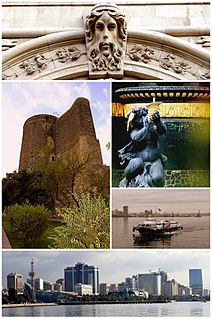Articles related to the Azerbaijan Republic include:

Baku Heydar Aliyev International Airport is one of the six international airports serving Azerbaijan. Formerly, it was called Bina International Airport by the name of a suburb in Baku. On 10 March 2004, the airport was renamed for the former president Heydar Aliyev, the third President of Azerbaijan. The airport is located 20 kilometers northeast of Baku, connected to the city by a modern highway, which was put into operation in 2008. The airport serves as the home base for national carrier Azerbaijan Airlines and Buta Airways.
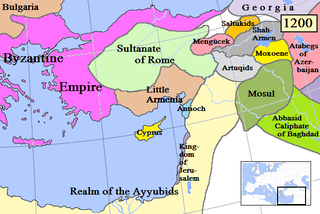
The Artquids or Artuqid dynasty was a Turkmen dynasty that ruled in Eastern Anatolia, Northern Syria and Northern Iraq in the eleventh and twelfth centuries. The Artuqid dynasty took its name from its founder, Zaheer-ul-Daulah Artuk Bey, who was of the Döger branch of the Oghuz and ruled one of the Turkmen atabeyliks of the Seljuk Empire. The Artuqid rulers viewed the state as the common property of the dynasty members. Three branches of the family ruled in the region: Sokmen Bey's descendants ruled the region around Hasankeyf between 1102 and 1231; Necmeddin Ilgazi's branch ruled from Mardin between 1106 and 1186 ; and the Mayyafariqin Artuqid line ruled in Harput starting in 1112, and was independent between 1185 and 1233.

Ramana also spelled Ramany, Romana, is an urban-type settlement and municipality in Azerbaijan, within the Sabunchu raion of Baku. Population (2005): 8,800.

Mirza Davud Baghir oglu Huseynov, also spelled Husseynov or Guseynov, was an Azerbaijani revolutionary and statesman.
Afag Masud is an Azerbaijani writer.
Architecture of Azerbaijan refers to the architecture development in Azerbaijan.

According to Azerbaijan's Center for Economic and Social Development, the country is in 39th place among 148 countries in tourism competitiveness indicators. The World Travel and Tourism Council reported that Azerbaijan is among the top ten countries with the greatest increase in visitor exports from 2010 to 2016. The country had the world's fastest-developing travel and tourism economy in 2017. To promote tourism, Azerbaijan sponsored Atlético Madrid jerseys reading "Azerbaijan – Land of Fire". In 2018 new tourism brend and slogan "take another look" were introduced.
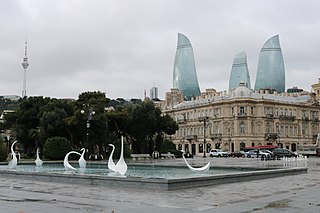
Baku Boulevard is a promenade established in 1909 which runs parallel to Baku's seafront. Its history goes back more than 100 years, to a time when Baku oil barons built their mansions along the Caspian shore and when the seafront was artificially built up inch by inch.

The architecture of Baku is not characterized by any particular architectural style, having accumulated its buildings over a long period of time.

The Bibi-Heybat Mosque is a historical mosque in Baku, Azerbaijan. The existing structure, built in the 1990s, is a recreation of the mosque with the same name built in the 13th century by Shirvanshah Farrukhzad II Ibn Ahsitan II, which was completely destroyed by the Bolsheviks in 1936.

Muhammad Mosque or Siniggala Mosque is the mosque built in the 11th century in Old City, Baku. The mosque is also known as Siniggala, for the name of its minaret – Siniggala. The mosque acquired its second name in 1723, when military squadron of Russian Army, consisting of 15 warships and led by Admiral Matyushkin, approached the city from seaside and demanded its surrender during the Russo-Persian War (1722-1723). Russian warships began to bomb the city after the refusal to surrender. One of the Russian shells hit the minaret of Muhammad Mosque and damaged it. A stormy wind then blew the Russian ships further out to sea. The population of the city interpreted the wind as a divine scourge sent to the occupants. From that time until the middle of the 19th century, the minaret of the mosque wasn’t reconstructed. It remained a symbol of the persistence and courage of the defendants of the tower.

Nizami Street is a large pedestrian and shopping street in downtown Baku, Azerbaijan, named after classical poet Nizami Ganjavi.
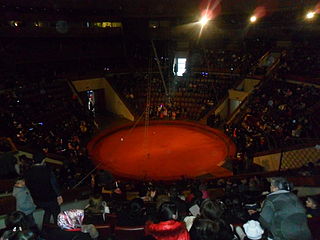
Baku State Circus is the main arena circus of Baku, capital of Azerbaijan.

Gasim bey Hajibababeyov – was an Azerbaijani architect.
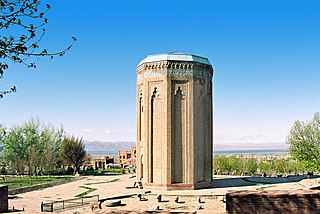
Architectural school of Nakhchivan – is one of architectural schools developed in the territory of modern Azerbaijan in medieval ages. The architectural school of Nakhchivan was founded by Ajami Nakhchivani in the 12th century. Mausoleums of Yusif ibn Kuseyir and Momine Khatun, constructed by him in Nakhchivan and are a classical type of constructions of this school.

Sovetsky is a historical inhabited locality in Baku's Yasamal district, Azerbaijan. It is located between Nariman Narimanov avenue and Mirza Ibrahimov street, and between Nizami and Ibrahim Abilov streets. There are a lot of historical buildings with the age more than 100 years, museums, mosques, baths, houses of notable Azerbaijani persons.

Church of the Holy Virgin or Holy Mother of God Church was an Armenian Apostolic church in the Old City (İçərişəhər) of Baku, Azerbaijan, built in the 18th century and demolished in 1992. It was on the southern side of the Maiden Tower at the turn of Neftyanikov Avenue between the caravansary, Barbara Street and Great Minaret Street.


